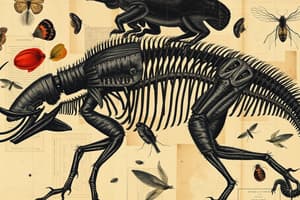Podcast
Questions and Answers
How do we keep track of different kinds of organisms?
How do we keep track of different kinds of organisms?
classification
How many major classification groups are there today?
How many major classification groups are there today?
seven
How are organisms grouped today?
How are organisms grouped today?
when they are alike in some ways
What is the largest classification group?
What is the largest classification group?
What does a kingdom contain?
What does a kingdom contain?
Members of a kingdom share only?
Members of a kingdom share only?
The kingdom is divided into?
The kingdom is divided into?
Name the groups a kingdom is divided into.
Name the groups a kingdom is divided into.
Think of the classification system as an?
Think of the classification system as an?
The groups at the top of the pyramid have?
The groups at the top of the pyramid have?
As the number of members increase,?
As the number of members increase,?
The groups at the bottom of the pyramid have?
The groups at the bottom of the pyramid have?
As the number of members decreases,?
As the number of members decreases,?
What has the smallest space in the pyramid?
What has the smallest space in the pyramid?
What is in species in the pyramid?
What is in species in the pyramid?
What are some organisms, like dogs and cats, classified into?
What are some organisms, like dogs and cats, classified into?
A member of a particular classification group has traits that are the same as?
A member of a particular classification group has traits that are the same as?
A member of a particular phylum has traits that are similar to?
A member of a particular phylum has traits that are similar to?
A member of a class shares some characteristics with?
A member of a class shares some characteristics with?
A member of an order shares some characteristics with?
A member of an order shares some characteristics with?
A member of a species shares some characteristics with?
A member of a species shares some characteristics with?
Which are more similar -- members of an order or members of a family?
Which are more similar -- members of an order or members of a family?
Which are more similar -- members of an order or members of a phylum?
Which are more similar -- members of an order or members of a phylum?
Which has more members -- a phylum or a family?
Which has more members -- a phylum or a family?
Which has more members -- a genus or a family?
Which has more members -- a genus or a family?
Which group has fewer members -- a family or a genus?
Which group has fewer members -- a family or a genus?
Which group has fewer members -- an order or a phylum?
Which group has fewer members -- an order or a phylum?
Which group has the most members?
Which group has the most members?
Which group has the least members?
Which group has the least members?
Besides a system of classification, what else did Linnaeus develop?
Besides a system of classification, what else did Linnaeus develop?
What is Linnaeus' system for naming organisms called?
What is Linnaeus' system for naming organisms called?
How are organisms named in binomial nomenclature?
How are organisms named in binomial nomenclature?
The first part of the name in Linnaeus' system is?
The first part of the name in Linnaeus' system is?
The second part of the name in Linnaeus' system is?
The second part of the name in Linnaeus' system is?
When a scientific name is written, what is italicized?
When a scientific name is written, what is italicized?
What is the scientific name for humans?
What is the scientific name for humans?
What is the scientific name for wolves?
What is the scientific name for wolves?
What is the scientific name for dandelions?
What is the scientific name for dandelions?
Study Notes
Classification Overview
- Classification is the method used to track and organize various types of organisms.
- There are seven major classification groups used today.
Classification Structure
- Organisms are grouped based on shared traits or characteristics.
- The largest classification group is the kingdom, which contains a wide variety of organisms.
- Within a kingdom, groups are further divided into smaller categories: phylum, class, order, family, genus, and species.
- The classification system is often visualized as an upside-down pyramid.
Pyramid Structure
- The top of the pyramid includes groups with more members, leading to less similarity among them.
- As one moves down the pyramid, group size decreases, and similarity among members increases.
- Species occupies the smallest space in the pyramid, representing a single kind of organism.
Organizational Relationships
- Organisms within the same classification group share specific traits with others in their group and higher classification levels.
- For example, members of a phylum share traits with all members of that phylum and kingdom.
- Members of a class share characteristics with their phylum and kingdom, while order members share traits with class, phylum, and kingdom members.
Comparison of Groups
- Members of a family are more similar than members of an order.
- A phylum contains more members than a family, while a genus has fewer members than a family.
- A family has fewer members compared to a phylum, but a genus has even fewer members than a family.
Domains and Species
- The group with the most members is the domain, while the group with the least members is species.
Linnaeus' Contributions
- Carl Linnaeus developed not only a classification system but also a naming system for organisms known as binomial nomenclature.
- In binomial nomenclature, each organism has a two-part scientific name consisting of a genus name (first part) and a species name (second part).
- The genus name is italicized in scientific writing, while the species name is not.
Scientific Names
- The scientific name for humans is Homo sapiens.
- The scientific name for wolves is Canis lupus.
- The scientific name for dandelions is Taraxacum officinale.
Studying That Suits You
Use AI to generate personalized quizzes and flashcards to suit your learning preferences.
Description
Test your knowledge on the major classification groups of organisms with these flashcards. Learn about how organisms are categorized and the different levels of classification in biology. Perfect for students looking to reinforce their understanding of biological classification.




